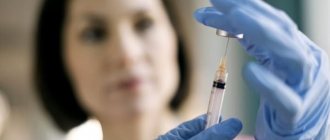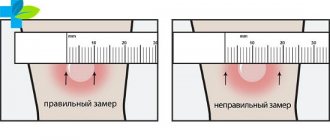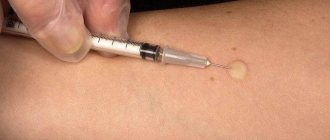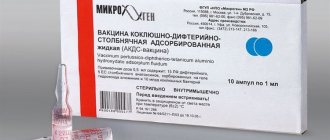What is Diaskintest at school
Russia is one of the few countries in the world where vaccination against tuberculosis is mandatory. Each child is given the BCG vaccine at birth, and then, several years later, according to the National Preventive Vaccination Calendar, revaccination is carried out. Thanks to this systematic approach, our country maintains a low incidence of tuberculosis.
However, such cases still occur. Tuberculosis is an insidious disease and can affect people with reduced immunity. Special tests can determine the presence of a pathogen in the body. Previously, only the Mantoux test was used for this purpose. There were no alternatives to it, so doctors had to put up with its “shortcomings.”
Firstly, a positive reaction, which often occurs not at all as a response to infection, but after BCG vaccination. Secondly, a positive reaction can persist for many years in people who have had the disease, but no longer pose a danger to others.
When testing a child and receiving a positive result, the doctor always has a difficult decision to make. Additional diagnostics, specific treatment - all this may not be necessary, but is prescribed by a specialist to dispel doubts.
With the advent of Diaskintest, these shortcomings are a thing of the past. The drug does not react with strains that are introduced into the body during vaccination. It is a combination of antigens of two types of tuberculosis bacteria that most often cause the disease. If these bacteria are not in the body, then there will be no reaction. Therefore, the question - which is better, Mantoux or Diaskintest - was decided by the Ministry of Health back in 2009.
“According to general recommendations, children aged one to seven years are given a Mantoux test,” said pediatrician Alexander Ushakov. - After eight years and up to 17 years - only Diaskintest. This drug is also used in adults. In addition, it is prescribed for the diagnosis of tuberculosis if the Mantoux test gives a positive result. Then Mantoux and Diaskintest are carried out almost simultaneously, a few days later.”
Mantoux test fails after vaccinations
Also, the Mantoux test is wrong if the child has a complication after vaccination for tuberculosis (it is called BCG, it is carried out in the first days after birth and at seven years). This was shown by the very first clinical study of Diaskintest. 150 people took part in it, and among them there were 20 children with complications after vaccination (they definitely did not have tuberculosis). In all 20 cases, the Diaskintest gave a correct negative result, and the Mantoux test in all 20 cases gave an erroneous positive result.
How to do Diaskintest for a child
The test is carried out strictly according to schedule. If we are talking about routine diagnostics, which are carried out annually in educational institutions, then at intervals of one year for all children over eight years of age. But this does not mean that the drug is prohibited for young children.
Diaskintest can be used as early as a year, but during this period it is not the drug of choice for a pediatrician. And it is used only to clarify the diagnosis in case of a positive Mantoux test.
If the patient is being treated for tuberculosis or is registered with a TB specialist, more frequent diagnosis may be required. The test is prescribed every three to six months and the result is assessed to determine the effectiveness of treatment.
On the eve of the diagnosis at school, parents are given statements of consent or refusal to perform the test. Every parent has the right to refuse it, but whether it is worth doing is not an idle question. Refusal can result in a latent course of the disease during the initial period of its development, when it can be overcome with treatment that is gentle on the child. An accurate and sensitive test that does not give “false-positive” results when performed correctly and following the doctor’s recommendations will allow you to detect the disease in time and prescribe timely therapy.
The test is performed in children's clinics, commercial clinics or in medical offices of schools. Special preparation for it is not required, it is only enough that the child is healthy. Diaskintest is not done for a runny nose or cold - only after complete recovery.
As they do not do when:
- exacerbation of a chronic disease;
- severe skin reactions;
- allergic condition;
- epilepsy.
“The drug is injected under the skin with a special syringe,” commented pediatrician Alexander Ushakov. — It has a thin short needle with an oblique cut. The skin is first wiped with a sterile cotton swab. The procedure is almost painless."
What is Diaskintest and why is it better than the Mantoux test?
The problem of tuberculosis, despite its centuries-old history, remains the most pressing problem of humanity. An important feature of the disease is that for a long time after infection there is a so-called latent phase of infection, when there are no disturbing symptoms, but diagnosis and preventive therapy are already possible. The most common method of the above diagnostics is the so-called skin tests, however, for most parents the terms “Diaskintest” and “Mantoux test” are meaningless, very scary words that are clearly related to vaccinations. Everything else, as a rule, is covered in the darkness of fear and misunderstanding.
I suggest you spend no more than 5 minutes, read, figure it out, calm down and stop being needlessly nervous.
So, the basics in the form of 15 theses:
- Everyone knows the disease - tuberculosis. The causative agent of tuberculosis is a microbe, the tuberculosis bacillus, scientific name is Mycobacterium tuberculosis.
- A special substance is obtained from mycobacteria - tuberculin . Tuberculin is a liquid that contains certain fragments of tuberculosis bacilli.
- The human body may or may not respond to tuberculin. What does this depend on? First of all, it depends on whether there is a tuberculosis bacillus in the human body or not. If an infection occurs (mycobacterium enters the body), it means that the immune system has experience of “communicating” with tuberculosis and will respond to the introduction of tuberculin. If there is no such experience, there will be no reaction.
- A small amount of tuberculin is injected intradermally with a thin needle. If the reaction is positive (redness, swelling), it means there is a tuberculosis bacillus in the body; if there is no reaction, there is no tuberculosis bacillus. This is the Mantoux test .
- Now it is clear that the Mantoux test is not a vaccination. This is a convenient and quick diagnostic test that allows you to promptly suspect a tuberculosis infection.
- “Why suspect?” - you ask. After all, everything is obvious: if the Mantoux test turns red, there is tuberculosis, if it doesn’t turn red, there is no tuberculosis. What is there to suspect! We need to treat! But not everything is so simple!
- What's the difficulty? First of all, mycobacteria can enter the human body in two main ways. The first method is natural: infection, usually through airborne droplets, after contact with a patient with tuberculosis. The second method is artificial: introducing a specially weakened tuberculosis bacillus into the body to form immunity to tuberculosis infection. “Introduction into the body to form immunity” is the vaccine against tuberculosis, and the “weakened tuberculosis bacillus” is the BCG vaccine.
- The complexity becomes clear! It turns out that a positive Mantoux test can be a sign of tuberculosis infection and require immediate treatment, and at the same time can be a consequence of the BCG vaccination given in the maternity hospital and the developed immunity. It is not at all easy to distinguish one from the other. Hundreds of instructions, tips and recommendations have been written on this matter, but there is almost never 100% certainty and, as a result, thousands of children “just in case” take far from harmless medications, since doubts remain, the cost of a mistake is high and no one wants to take risks.
- Remember what tuberculin is? — A liquid containing certain fragments of tuberculosis bacilli. And the sticks, as we already know, are of two types: wild, dangerous, those that cause diseases, and weakened, those that are used for vaccination and are part of the BCG vaccine. Now very important information: it turns out that the dangerous tuberculosis bacillus has several special proteins that are absent in the weakened bacillus.
- Scientists were able to isolate these “special proteins” and create a drug based on them that is similar to tuberculin and allows skin testing. Both the drug itself and the diagnostic test with this drug are called Diaskintest .
- A unique and very valuable feature of Diaskintest is that the BCG vaccination does not affect the result in any way! Diaskintest becomes positive only when the body is infected with Mycobacterium tuberculosis, which has caused or is actually capable of causing the disease.
- Now it becomes clear that the majority of children have a negative Diaskintest, and the Mantoux reaction is positive, since most children received the BCG vaccine. A positive Mantoux is a reason to observe and continue the examination. A negative Diaskintest is a reason to calm down: everything is fine!
- A negative Diaskintest indicates that there is no active tuberculosis infection in the child’s body.
- The advantages of Diaskintest, or the answer to the question why it is better than the Mantoux test:
- the main and obvious advantage: the absence of positive reactions associated with BCG vaccination;
- high sensitivity: i.e. if there is a tuberculosis infection, the test will be positive with a probability approaching 100%;
- high specificity: if the sample is positive, then with a probability approaching 100% it is tuberculosis, and not something else that can affect the result;
- when carrying out Diaskintest, excessively strong reactions are much less common than when carrying out the Mantoux test;
- if a medical worker knows how to perform a Mantoux test, it will not be difficult for him to master Diaskintest: the technique of performing Diaskintest is practically no different from the technique of performing a Mantoux test. The indications and contraindications, methods and timing of reaction assessment are very similar.
- The special value of Diaskintest is that its use makes it possible to reduce by tens of times the number of children who unreasonably receive anti-tuberculosis antibiotics. But it is precisely the massive and often unjustified use of anti-tuberculosis drugs that leads to the emergence of particularly dangerous forms of the disease, in which the tuberculosis bacillus turns out to be resistant to most drugs.
PS Did you know that the site where the Mantoux test is performed cannot be rubbed, scratched, smeared with brilliant green or covered with a band-aid? But you can wet this place!
Diaskintest can also be wetted! Swim to your health.
author Komarovsky E.O. published 23/03/2018 23:36 updated 07/05/2020
Is it possible to be allergic to Diaskintest?
An allergic reaction is an individual manifestation of the activity of the immune system. It is impossible to predict how the immune system will behave when it is “acquainted” with a new drug. The test will not necessarily provoke an allergy, even in a child prone to food allergic reactions. But if this tendency exists, it would not be a bad idea to prepare for the injection.
According to Alexander Ushakov, children with allergies are recommended to start taking an antihistamine five days before the test and continue the course for two more days after it. If severe swelling occurs at the injection site, which obviously corresponds to an allergic reaction to Diaskintest, the course of the antihistamine should be extended, according to the doctor’s recommendation. And in the future, a child with allergies will be prescribed a Mantoux test instead of this test.
X-ray or manta for children: what to do, which is more harmful?
Few young children enjoy the Mantoux test, or any injections. And parents are worried that the Mantoux test can infect their child with tuberculosis, since the drug uses a strain of this disease. In fact, the Mantoux test is a non-living mycobacterium tuberculosis that cannot infect the body, but will provoke a reaction if infected. On the other hand, when deciding which is more harmful, Mantoux or x-rays, it is worth knowing that the reaction to tuberculin contained in the preparation for the Mantoux test may be different for each child. Often the reason for refusing it is an allergic reaction to the drug or individual intolerance.
After how many days is Diaskintest checked?
Immediately after administration of the drug, a papule may form at the injection site, which usually disappears quickly. But the final result of the Diaskintest is assessed only after 72 hours. The specialist evaluates the injection site visually and is guided by the severity of the reaction.
- Norm . There is no redness or hardness at the injection site. Only a trace of the wound may be observed when a needle with a diameter of up to two millimeters is inserted. This result indicates that the diaskintest is negative, that is, there is no tuberculosis pathogen in the body.
- Questionable reaction . In this case, there may be redness at the injection site. In this case, there should be no infiltration, that is, compaction. A questionable reaction is not an indicator of a bad diaskintest, but requires attention from the doctor to the patient.
- Pronounced reaction . It can be mild - in which a dense papule up to 5 mm in size forms and persists. Moderately expressed - in which the infiltrate can reach 9 mm. Or pronounced - when the size of the compaction reaches 14 mm. With a diameter of 15 mm or more, we are talking about a hyperergic reaction. In each case, the diaskintest is considered positive, that is, it may indicate the presence of the tuberculosis pathogen in the body.
“We can definitely say that the test is bad if there is an infiltrate of any size,” clarifies Alexander Ushakov. “With a high degree of probability, it indicates tuberculosis infection. But sometimes an allergic reaction to the components of the drug may occur. Therefore, if the test is questionable or positive, the patient must be examined and examined by a phthisiatrician to exclude infection or tuberculosis.”
pixabay.com/
Diaskintest - what not to do so as not to “smear” the result
In order for the Diaskintest assessment to be objective, you should follow the rules of caution after the injection. Despite its low sensitivity to liquid ingress, it is still not recommended to wet the injection site. Otherwise, the reaction may be false positive.
In addition, you should not scratch the injection site to avoid causing swelling and redness. Do not rub or cover with a band-aid, which parents sometimes do when bathing a child, to prevent water from getting into the wound. Since the drug is injected under the skin on your arm, it is best to keep the pen away from the water while bathing in the shower. Covering with a band-aid and trying to thoroughly wipe the papule dry can lead to an unpleasant reaction. These rules must be followed until the sample is “read” by a specialist for three days.
Diaskintest is also carried out for adults, but strictly according to indications. It is done only in tuberculosis dispensaries. And they are used directly to diagnose tuberculosis or evaluate the effectiveness of treatment previously prescribed by a doctor. The method for assessing the result is the same as the rules for preparing for the test and recommendations after it.











